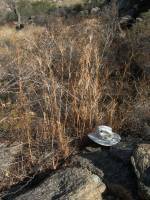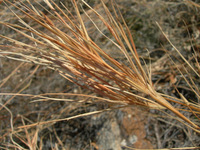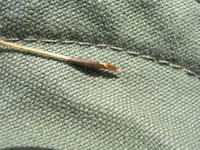Plants annual. Culms 50-200 cm, often with prop roots, freely branching above the base. Sheaths glabrous, with a row of glandular depressions along the keel; ligules 2-4 mm, erose to lacerate, glabrous; blades 30-50 cm long, 3-12 mm wide, usually folded, abaxial surfaces with dark glandular depressions along the keel, adaxial surfaces with scattered papillose-based hairs near the base, scabrous elsewhere. Rames 2.5-6.5 cm. Homogamous spikelets 10-14 mm, green; lower glumes glabrous, unawned. Heterogamous spikelets: sessile spikelets 8-11.5 mm, dark brown, awned; calluses about 3 mm; awns 10-15 cm; pedicellate spikelets 16-21 mm, unawned; lower glumes scabrous or sparsely ciliate distally, midveins glandular, pitted. 2n = 20.
Heteropogon melanocarpus is probably native to the Eastern Hemisphere, but is now found in tropical regions throughout the world. It grows in pine woods, fields, and disturbed areas of the southern United States. When fresh, plants of H. melanocarpus smell like citronella oil.
Common Name: sweet tanglehead
Duration: Annual
Nativity: Native
Lifeform: Graminoid
General: Coarse annual with stems 50-200 cm, little or not at all branched at base, but with short, raceme-bearing branches at upper nodes.
Vegetative: Sheaths keeled, glabrous, with a row of glandular depressions along keel; ligules 2-4 mm, erose to lacerate, glabrous; blades 30-50 cm long, 3-12 mm wide, usually folded, scabrous, with scattered papillose-based hairs near the base of the adaxial (upper)
Inflorescence: Raceme with inflorescence branches bearing pedicillate-sessile spikelet pairs, the lowest few spikelet pairs homogamous and unawned, 10-14 mm, green, with glabrous lower glumes; distal spikelet pairs heterogamous, the sessile spikelets long-awned, 8-12 mm, dark brown, with calluses 3 mm and awns 10-15 cm; pedicellate spikelets of the heterogamous pairs unawned,16-21 mm, the lower glumes scabrous or sparsely ciliate below, with glandular midveins.
Ecology: Found on rocky slopes and flats, often weedy, from 3,000-5,500 ft (914-1676 m); flowers July-November.
Distribution: Tropical regions throughout the world; in the US it is found in s AZ from the Santa Catalina Mountains southward into n MEX, also TX, AL, GA, FL, SC, NC.
Notes: Similar to the more common and widespread perennial Heteropogon contortus, but this taxon is annual, with taller stems that are less branched below. Also look for glands on the midnerve of the upper sheaths, and on the first glume of the pedicillate spikelets; H. melanocarpus has these glands but H. contortus does not. When fresh, the plants smell like citronella oil.
Ethnobotany: Unknown
Etymology: Heteropogon is from Greek for differently or variously bearded, alluding to the difference between the awnless-homogamous spikelets and the awned-heterogamous spikelets; melanocarpus comes from the the Greek melan for black and karpos for seed.
Synonyms: Andropogon melanocarpus
Editor: SBuckley 2010, AHazelton 2015









